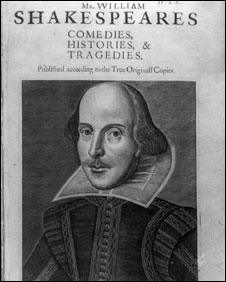Theft accused 'planned to sell' 1623 Shakespeare folio
- Published

Mr Scott denies theft and handling stolen goods
A man accused of stealing a first edition of Shakespeare's works planned to share money from its sale with a cocktail waitress, a court has heard.
Raymond Scott, 53, is accused of taking the folio from Durham University in 1998, and waiting 10 years before trying to sell it.
Newcastle Crown Court heard the damaged folio was the "most important" printed book in English literature.
Mr Scott of Wingate, County Durham, denies theft and handling stolen goods.
In 2008 Mr Scott took the 400-year-old book to the Folger Shakespeare Library in Washington DC to have it authenticated.
Waitress 'infatuation'
Posing as a wealthy playboy, he told researchers he had been entrusted with the folio by friends in Cuba, who believed it might be valuable, the court heard.
But experts suspected the book, printed in 1623, was stolen and called in the British Embassy, Durham Police and the FBI.
The court heard how Mr Scott had recently become infatuated with a young Cuban waitress, Heidy Garcia Rios, and had planned to sell the folio and share the proceeds with her and his friend Deni Mareno Leon, a retired Cuban Army commandant.

The folio has been "mutilated" since its theft 12 years ago
Former Durham University librarian and keeper of rare books Ian Doyle told the trial: "It is the most important printed book of English literature, since its contents are all, or virtually all, of Shakespeare's plays."
Dr Doyle said the folio was identifiable because of the way it was printed and the handwritten note on the catalogue page referring to the play Troilus And Cressida.
He said the book, which was normally kept in a safe, was stolen from a reinforced exhibition cabinet protected by three mortise locks.
He also said university staff also did not realise immediately that the folio was gone because it was covered in blankets to protect it from the sun.
The court has heard that Mr Scott "mutilated" the folio, removing both the covers, the frontispiece, final page and binding in an effort to disguise its provenance.
Independent experts have said the book, even in its damaged state, is worth about £1m.
The trial continues.
- Published17 June 2010